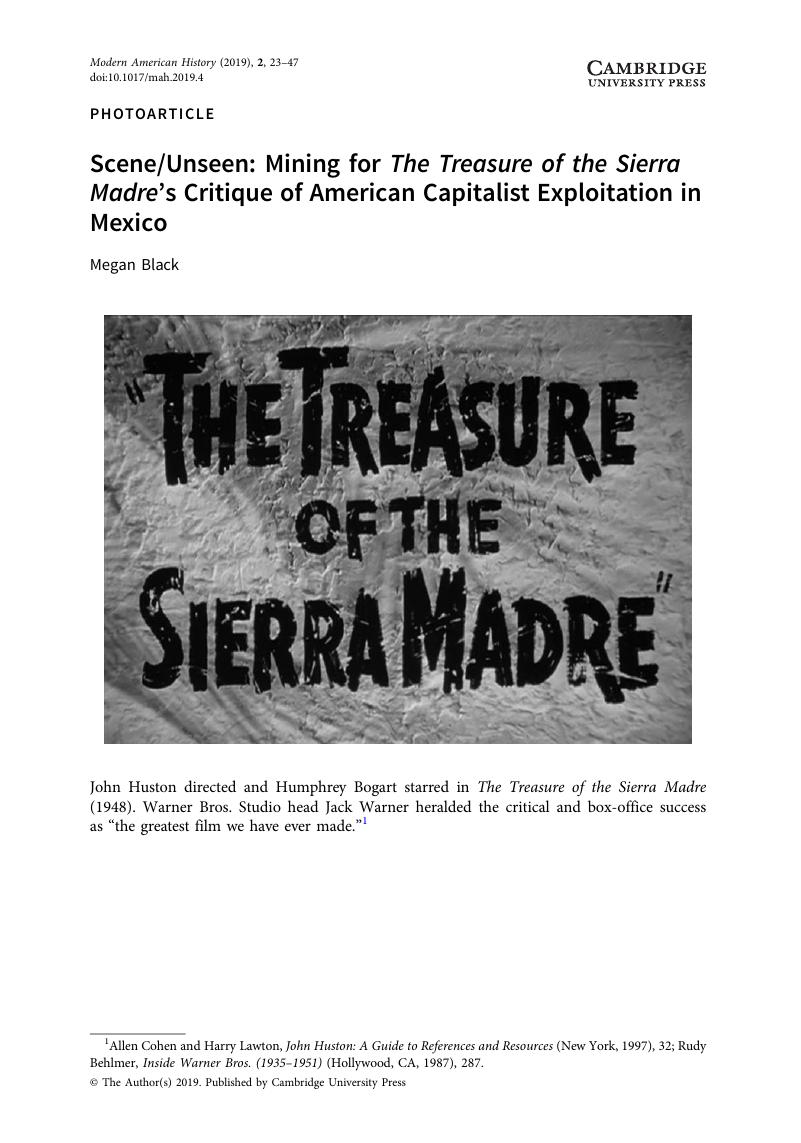No CrossRef data available.
Published online by Cambridge University Press: 27 March 2019

1 Cohen, Allen and Lawton, Harry, John Huston: A Guide to References and Resources (New York, 1997), 32Google Scholar; Behlmer, Rudy, Inside Warner Bros. (1935–1951) (Hollywood, CA, 1987), 287Google Scholar.
2 Brown, Jonathan C., Oil and Revolution in Mexico (Berkeley, CA, 1993)Google Scholar.
3 Research Record, Treasure of the Sierra Madre, Feb. 13, 1948, folder Treasure of the Sierra Madre #680, box 1, Warner Bros. Archives, School of Cinematic Arts, University of Southern California, Los Angeles, CA [hereafter WBA].
4 “Conference Notes,” Script, 1–3, folder The Treasure of the Sierra Madre–script notes undated, John Huston Papers, Margaret Herrick Library of the Academy of Motion Pictures Arts and Sciences, Beverly Hills, CA [hereafter JHP].
5 “Conference Notes,” JHP.
6 Huston, John, An Open Book (New York, 1980), 42–7Google Scholar and 143–8. On the cultural front, see Denning, Michael, The Laboring of American Culture in the Twentieth Century (New York, 1996)Google Scholar. For a window onto leftists and artists in Mexico after the Mexican Revolution, see Delpar, Helen, The Enormous Vogue of Things Mexican: Cultural Relations between the United States and Mexico, 1920–1935 (Tuscaloosa, AL, 1995)Google Scholar, especially Ch. 5. On Huston's ties to this network, see Adriana Williams's and Doris Ober's biography of the renowned and well-networked cartoonist Miguel Covarrubias, Covarrubias (Austin, TX, 1994).
7 Gilderhus, Mark T., Diplomacy and Revolution: U.S.–Mexican Relations under Wilson and Carranza (Tucson, AZ, 1977), 80Google Scholar; Brown, Oil and Revolution in Mexico, 240–1; Truett, Samuel, Fugitive Landscapes: The Forgotten History of the U.S. Mexico Borderlands (New Haven, CT, 2008), 171–3Google Scholar; Katz, Friedrich, “Pancho Villa and the Attack on Columbus, New Mexico,” American Historical Review 83, no. 1 (Feb. 1978): 101–30CrossRefGoogle Scholar, especially 104–5; John, Rachel St., Line in the Sand: A History of the Western U.S.–Mexico Border (Princeton, NJ, 2011)Google Scholar, ch. 3, and 135–8. On the range of Americans living and doing business in early twentieth century Mexico, see Hart, John Mason, Empire and Revolution: The Americans in Mexico since the Civil War (Berkeley, CA, 2002)CrossRefGoogle Scholar.
8 On Huston's interest, see Huston, An Open Book, 143. On B. Traven's biography, see Engell, John, “Traven, Huston, and the Textual Treasures of the Sierra Madre,” in Studlar, Gaylyn and Desser, David, eds., Reflections in a Male Eye: John Huston and the American Experience (Washington, DC, 1993), 79–96Google Scholar; Ginna, Robert Emmett Jr., “In Search of The Treasure of the Sierra Madre,” The American Scholar 71, no. 4 (Autumn 2002): 75–89Google Scholar. On Traven's interest in the historical exploitation of the U.S.–Mexico border region for its mineral wealth, see Taylor, Lawrence D., “B. Traven's The Treasure of the Sierra Madre and the Continuing Allure of ‘Gold Glitter’ in the U.S.–Mexico Borderlands Region,” Journal of the Southwest 60, no. 3 (Autumn 2018): 678–98CrossRefGoogle Scholar. For correspondence between Huston and Traven speaking to the similarities and differences in their visions, see Cohen and Lawton, John Huston, 279–83.
9 Huston, An Open Book, 143.
10 Herman Lissuer to John Huston, “Treasure of the Sierra Madre,” May 13, 1946, WBA. On the revisions to the Mexican Constitution in the Venustiano Carranza administration, see Meyer, Lorenzo, Mexico and the United States in the Oil Controversy, 1917–1942 (Austin, TX, 1977)Google Scholar.
11 This casting possibility is mentioned in correspondence between Huston and Traven in December 1946. See Cohen and Lawton, John Huston, 283.
12 John Huston, The Treasure of the Sierra Madre script, 1–2, 1945, folder The Treasure of the Sierra Madre–script 1945, JHP.
13 John Huston, Conference Notes, undated, folder The Treasure of the Sierra Madre–script notes undated, JHP.
14 Gardner, Gerald C., The Censorship Papers: Movie Censorship Letters from the Hays Office 1934–1968 (New York, 1987), xxiiGoogle Scholar.
15 Lillian Ross, “Come in, Lassie,” The New Yorker, Feb. 21, 1948, 40–2. The explanation, moreover, conforms to Marx's definition of the commodity, an “external object” that is put to use for various human purposes, but which can only be brought into relation with other objects of differing use-values through a comparison of the labor-power required to produce each object. Karl Marx, Capital: A Critique of Political Economy, Volume I, trans. Ben Fowkes (London, 1990), 125–8.
16 Henry Blanke to Geoffrey Sherlock, June 26, 1942, folder The Treasure of the Sierra Madre–John Huston 1948, Motion Picture Association of America and Production Code Administration Records, JHP.
17 Sadlier, Darlene J., Americans All: Good Neighbor Cultural Diplomacy in World War II (Austin, TX, 2013), 1–8Google Scholar.
18 Gardner, Censorship Papers, xxii.
19 Doherty, Thomas, Show Trial: Hollywood, HUAC, and the Birth of the Blacklist (New York, 2018), 92CrossRefGoogle Scholar.
20 Huston, An Open Book, 134. On the renunciation, see Humphrey Bogart, “I'm No Communist,” Photoplay, March 1948, 52 and 86.
21 President Truman delivers a campaign speech at Gilmore Stadium in Los Angeles, Sept. 23, 1948, Accession Number 85-08-3, Truman Library Photographs, Harry S. Truman Library and Research Institute, Kansas City, MO [hereafter HSTL]. On Reagan's political transformation from Democratic campaigner to bastion of conservatism, see Rogin, Michael Paul, Ronald Reagan, the Movie: And Other Episodes in Political Demonology (Berkeley, CA, 1988)Google Scholar.
22 On U.S.–Latin American relations in the Truman era, see Grandin, Greg, Empire's Workshop: Latin America, the United States, and the Rise of the New Imperialism (New York, 2006), 39–46Google Scholar; Cobbs, Elizabeth A., The Rich Neighbor Policy: Rockefeller and Kaiser in Brazil (New Haven, CT, 1992)CrossRefGoogle Scholar. On mineral investments overseas under Truman, see Black, Megan, “Interior's Exterior: The State, Mining Companies, and Resource Ideologies in the Point Four Program,” Diplomatic History 40, no. 1 (Jan. 2016): 81–110Google Scholar.
23 Log of President Truman's Trip to Puerto Rico, The Virgin Islands, Guantanamo Bay, Cuba, and Key West Florida, February 20, 1948 to March 5, 1948, 31–33, President Truman's Travel Logs, HSTL. On the history of U.S. sovereignty in Guantanamo Bay, see Kaplan, Amy, “Where Is Guantanamo?” American Quarterly 57, no. 3 (Sept. 2005): 831–58CrossRefGoogle Scholar.